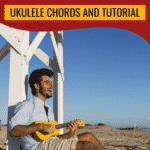There are few modern pop songs that have featured the ukulele as prominently as Vance Joy’s “Riptide”. The song catapulted the Australian singer-songwriter into mainstream popularity, and the uke Joy plays is essentially the thread that ties the whole piece together.
If you’ve been wondering how do you play “Riptide” on ukulele, then you’ll probably be pleased to know that the song is based around a few simple and widely-used ukulele chords. It should be relatively easy for beginners to learn, and as an added bonus, you’ll find all of the chords that make up the song in other pieces of music, too.
So, once you’ve learned how to play “Riptide” on ukulele, you’ll be in a great position to play countless other classic songs from other genres on the ukulele as well. Something that is worth noting about “Riptide” is that the tempo is somewhat quick, which might make it challenging to keep up at first. If you’re struggling to play along, try slowing the chord changes down and playing through them until you’ve committed them to muscle memory.
Find more easy ukulele songs here >>> 57+ Easy Ukulele Songs for Beginners (using basic chords)
Post Contents
“Riptide” – Ukulele Chords
The basic ukulele chords used in the song “Riptide” are Am, G, C, Gsus4, and Fadd9.
All of these chords are fairly simple to play and mostly based around open strings. So, it shouldn’t take too much time before you can play “Riptide’s” ukulele chords confidently and with ease.
Something that may be challenging to beginners is the change from Am to G, though. Playing G on the ukulele does require fretting three of the four strings, and doing so up to tempo can be tricky, especially since “Riptide” is a relatively quick song.
If you feel that you can’t play the change smoothly or find yourself making a lot of mistakes, try practicing the change at a slower tempo. Playing along to a metronome will help you keep good time and rhythm. Once you’ve practiced so much that it feels like second nature, then you can try playing “Riptide” up to speed and play through the entire chord progression without stopping.
The progression that plays through the intro of “Riptide” is essentially the same throughout the entire song, apart from a short bridge which features the Gsus4 and Fadd9. Here’s a breakdown of “Riptide” uke tabs:
Intro
[Am] [G] [C] x2
Verse
[Am] [G] [C]
This chord progression is repeated in the same order throughout each of the verses in “Riptide”. There are no changes in timing or rhythm, so locking into the groove of the song feels fairly natural here.
[Am] I was scared of [G] dentists and the [C] dark
[Am] I was scared of [G] pretty girls and [C] starting conversations
[Am] Oh, all my [G] friends are turning [C] green
[Am] You’re the magician’s [G] assistant in their [C] dreams
[Am] Ooh, [G] ooh, [C] ooh
[Am] Ooh, [G] and they [C] come unstuck
Chorus
For the chorus, you will more or less play the same progression as in the verse. However, the timing of the changes is slightly different to how it is in the verses.
[Am] Lady, [G] running down to the [C] riptide
[C] Taken away to the [Am] dark side
[G] I wanna be your [C] left hand man
[Am] I love you [G] when you’re singing that song [C] and
[C] I got a lump in my [Am] throat, ‘cause
[G] You’re gonna sing the words [C] wrong
Bridge
This is the part of the song which includes the Gsus4 and Fadd9 chords. While their names might look unfamiliar at first, they’re fairly simple to play and sound great to boot!
[Am] I just wanna, I just wanna know [Gsus4] [G]
[C] If you’re gonna, if you’re gonna stay [Fadd9]
[Am] I just gotta, I just gotta know [Gsus4] [G]
[C] I can’t have it, I can’t have it any other way [Fadd9]
View the complete ukulele chord chart for “Riptide” here.
“Riptide” Uke Strum Pattern
“Riptide” actually features two different strumming patterns. There’s the pattern that plays throughout the verse, and then a slightly more ‘active’ version in the choruses.
The first pattern should be played like this:
D – U – – D U D
1 + 2 + 3 + 4 +
The following is the second, slightly more rhythmically complex strumming pattern:
D – x D – U X U
1 + 2 + 3 + 4 +
The ‘x’ in the strumming pattern denotes a chuck or ghost note, which are to be played on the upstrokes. In “Riptide”, Vance Joy performs something which is like a partial chuck, so you can still hear the chord but it is given a percussive quality. When playing this pattern, make sure not to completely deaden the strings so that the chord rings through.
This technique may be slightly challenging for beginners. If you haven’t tried chucking before, it can take some getting used to as it will require you learning a separate strumming technique. As such, if you’re struggling with this part of the strumming pattern, then you can just leave it out in order to simplify things. It’s a small detail that won’t drastically impact the overall performance.
If you would like to really nail the second strumming pattern, then you can incorporate chucking into your ukulele practice. It is a fairly fundamental technique which is used in lots of different types of music that features the ukulele. Since it’s a great way to add some type of percussion to your playing and is so ubiquitous in the ukulele world, you’re pretty likely to learn it sooner or later. So, why not learn it now?
Video Tutorial
The following is a great video tutorial that runs through the chords you will need to play “Riptide” by Vance Joy on ukulele:
Enjoyed this tutorial?
If you enjoyed this song tutorial, you might like messing around with these ukulele songs as well:
- “Stay with Me” by Sam Smith (Am, C, F, G)
- “Someone Like You” by Adele (C, G, Am, F)
- “Sweet Home Alabama” by Lynyrd Skynyrd (D, C, G)
Or, check out our full list of easy ukulele songs for beginners for even more songs to play.







